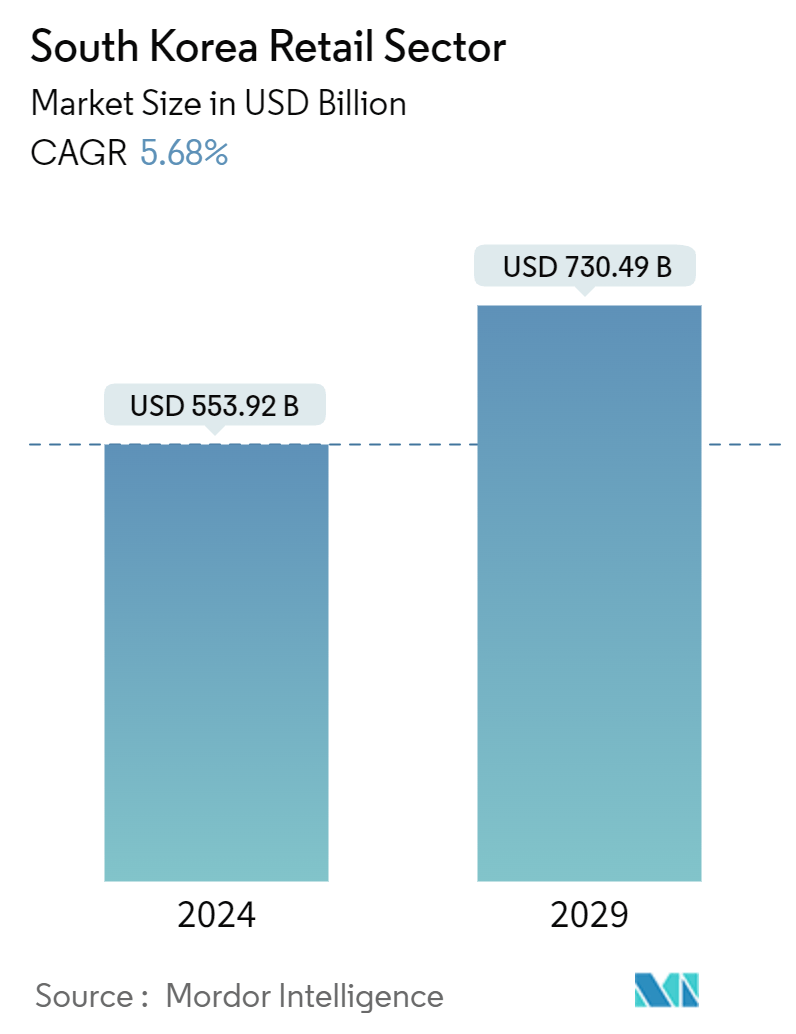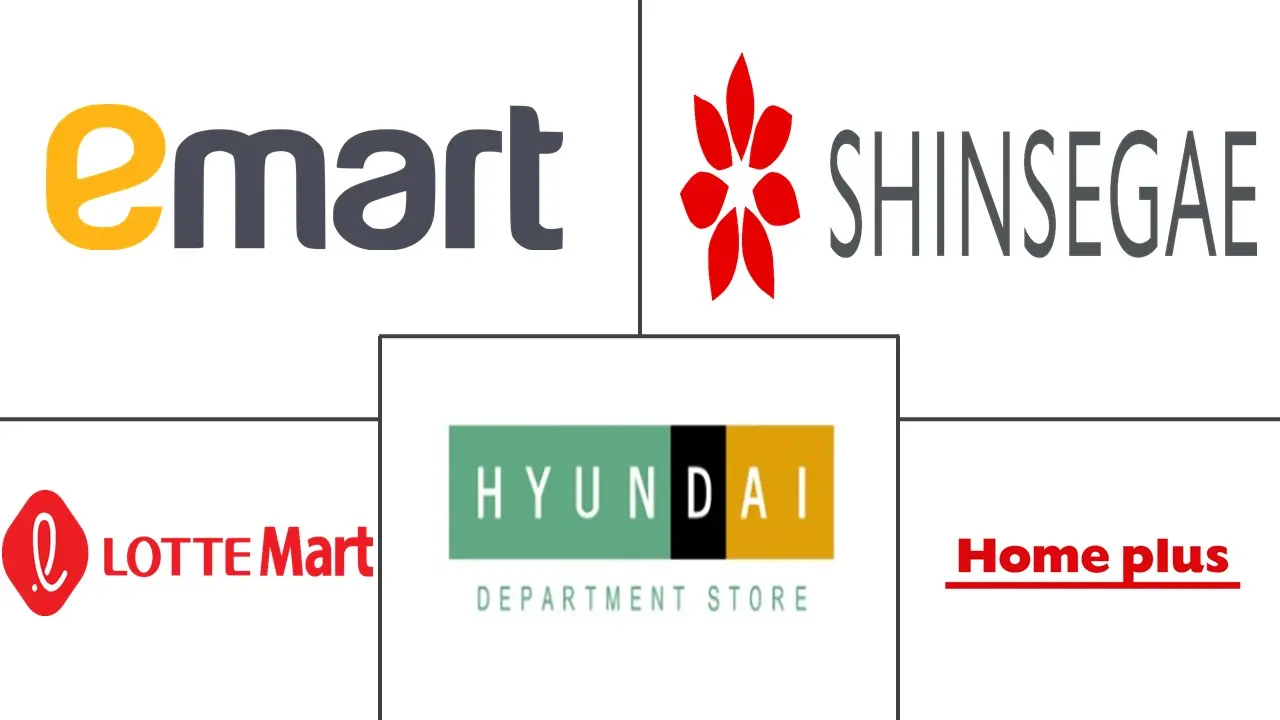Market Size of South Korea Retail Sector

| Study Period | 2020 - 2029 |
| Base Year For Estimation | 2023 |
| Market Size (2024) | USD 553.92 Billion |
| Market Size (2029) | USD 730.49 Billion |
| CAGR (2024 - 2029) | 5.68 % |
| Market Concentration | Low |
Major Players
*Disclaimer: Major Players sorted in no particular order |
South Korea Retail Sector Market Analysis
The South Korea Retail Market size is estimated at USD 553.92 billion in 2024, and is expected to reach USD 730.49 billion by 2029, growing at a CAGR of 5.68% during the forecast period (2024-2029).
The retail sector in South Korea is growing significantly due to its consistent economic growth and growing middle-class population, which has been essential in driving consumer expenditure. The growth in the middle-income population improves the spending power of consumers for a wide range of products and services. Healthy eating habits have gained popularity among educated consumers and are regularly featured in print and broadcast media. Fresh foods, fruit juices, fruit concentrated-based beverages, organic foods, sugar-free confectionery, packaged food with higher fiber content, dairy products, and vitamin and calcium-fortified packaged food and beverages are also preferred by middle to upper-income consumers.
Further, the increasing urban population has also concentrated potential customers in large cities, resulting in the development and expansion of retail stores. In contrast, the retail landscape has been revolutionized by the rapid adoption of digital advancements and the cumulative popularity of e-commerce platforms in the country, making it easier for businesses to influence consumers to gain access to a wide range of products and services. Revenue for offline and online retailers has increased. The popularity of online shopping has increased across the globe. Food and groceries were the most frequently purchased online. The aging population and rising number of single-person households in South Korea drive convenience and small-portion F&B product innovation.
South Korea Retail Sector Industry Segmentation
Retail is offering goods or services through various distribution channels to earn a profit. A complete background analysis of the South Korean retail industry, which includes an assessment of the parental market, emerging trends by segments, significant market dynamic changes, and a market overview, has been covered in the report.
The South Korean Retail Sector Market is segmented by product category and distribution channel. By product, the market is sub-segmented into food, beverage, and tobacco products; personal care and household, apparel, footwear, and accessories, furniture, toys, and hobby, industrial and automotive, electronics and household appliances, and pharmaceuticals and luxury goods. Under distribution channel, the market is sub-segmented into online and offline channels. The report offers market size and forecasts in value (USD) for all the above segments.
| Product Type | |
| Food, Beverage, and Tobacco Products | |
| Personal Care and Household | |
| Apparel, Footwear, and Accessories | |
| Furniture, Toys, and Hobby | |
| Industrial and Automotive | |
| Electronic and Household Appliances | |
| Pharmaceuticals and Luxury Goods |
| Distribution Channel | |
| Online | |
| Offline |
South Korea Retail Sector Size Summary
The South Korean retail sector is experiencing robust growth, driven by consistent economic expansion and an increasing middle-class population that boosts consumer spending power. This demographic shift has led to a heightened demand for a diverse range of products, particularly those aligned with healthy eating trends, such as organic and fortified foods. The urbanization trend has further concentrated potential customers in major cities, facilitating the expansion of retail stores. The retail landscape is also undergoing a transformation due to the rapid adoption of digital technologies and the growing popularity of e-commerce platforms, which have made it easier for consumers to access a wide array of products and services. This shift has resulted in increased revenues for both offline and online retailers, with food and groceries being among the most frequently purchased items online.
South Korea's retail market is significantly influenced by its strong e-commerce sector, which benefits from high internet penetration and a tech-savvy population. The food and beverage industry constitutes a substantial portion of the retail market, with grocery stores leading the sector by offering competitively priced, high-quality local products. Despite economic challenges, sectors like food retailing, luxury goods, and electronics have shown resilience. The market is dominated by major players such as Hyundai Home Shopping Network Corp., Shinsegae Department Co. Ltd, Lotte Mart, E-Mart Inc., and Homeplus Co. Ltd, although mid-size and smaller companies are gaining ground through technological advancements and service innovations. Recent developments include Lotte Mart's initiative to create shopping zones for non-Korean tourists and the opening of Five Guys' first store in Seoul, highlighting the dynamic nature of the retail industry in South Korea.
South Korea Retail Sector Market Size - Table of Contents
-
1. MARKET DYNAMICS AND INSIGHTS
-
1.1 Market Overview
-
1.2 Market Drivers
-
1.2.1 Growing Tourism in South Korea
-
1.2.2 Growing Awareness About Healthy Lifestyle Products
-
-
1.3 Market Restraints
-
1.3.1 Regulatory Compliance Impedes Market Growth
-
1.3.2 Infrastructure Challenges Acts as Restraint to Market Growth
-
-
1.4 Market Opportunities
-
1.4.1 Online Sales and Introduction of Retail Mobile Applications
-
1.4.2 Technological Advancments such as Adpotion of AI and Virtual Reality
-
-
1.5 Industry Value Chain Analysis
-
1.6 Industry Attractiveness - Porter's Five Forces Analysis
-
1.6.1 Threat of New Entrants
-
1.6.2 Bargaining Power of Buyers
-
1.6.3 Bargaining Power of Suppliers
-
1.6.4 Threat of Substitute Products and Services
-
1.6.5 Intensity of Competitive Rivalry
-
-
1.7 Insights on Technology Innovation in the Market
-
1.8 Impact of COVID-19 on the Market
-
-
2. MARKET SEGMENTATION
-
2.1 Product Type
-
2.1.1 Food, Beverage, and Tobacco Products
-
2.1.2 Personal Care and Household
-
2.1.3 Apparel, Footwear, and Accessories
-
2.1.4 Furniture, Toys, and Hobby
-
2.1.5 Industrial and Automotive
-
2.1.6 Electronic and Household Appliances
-
2.1.7 Pharmaceuticals and Luxury Goods
-
-
2.2 Distribution Channel
-
2.2.1 Online
-
2.2.2 Offline
-
-
South Korea Retail Sector Market Size FAQs
How big is the South Korea Retail Market?
The South Korea Retail Market size is expected to reach USD 553.92 billion in 2024 and grow at a CAGR of 5.68% to reach USD 730.49 billion by 2029.
What is the current South Korea Retail Market size?
In 2024, the South Korea Retail Market size is expected to reach USD 553.92 billion.

